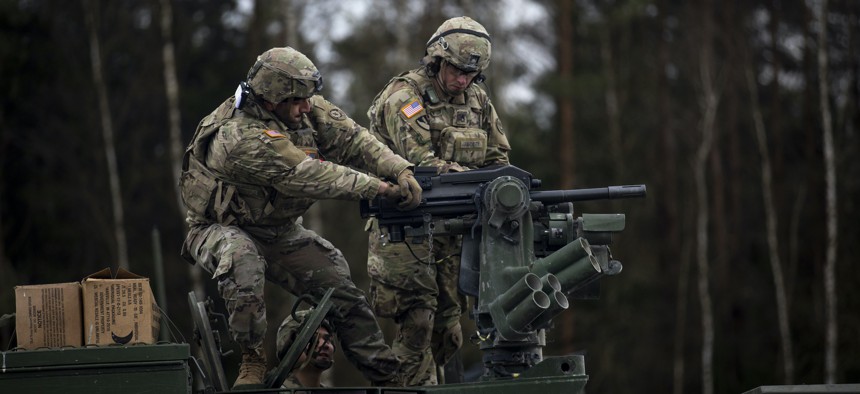
U.S. soldiers reload a MK-19 grenade launcher on a Stryker vehicle during a live-fire exercise at the 7th Army Training Command’s Grafenwoehr Training Area, Germany, Jan. 18, 2022. U.S. Army / Spc. Nathaniel Gayle
U.S. Sends 3,000 Troops to NATO’s Eastern Flank In Response to Russian Buildup
Stryker squadron heads to Romania; 1,700 from 82nd Airborne will head to Poland in “coming days.”
Updated 1:56 p.m. ET to add Psaki statement.
President Biden is sending 3,000 U.S. troops “in coming days” to Romania and Poland as Russia continues its military buildup along the Ukrainian border, Pentagon press secretary John Kirby announced Wednesday.
The troops will be in addition to the 8,500 that have been put on “heightened alert” but not yet activated in the United States.
About 1,700 members of an 82nd Airborne Division infantry brigade combat team will be sent from Fort Bragg, North Carolina, to Poland. Some 300 soldiers from the 18th Airborne Corps will fly to Germany to support a headquarters unit.
As well, a Stryker squadron of about 1,000 soldiers will shift from Germany to Romania.
“The 2nd Cavalry Regiment, a mounted unit based in Vilseck, Germany, will send a combined arms force equipped with wheeled armored fighting vehicles to deter aggression and enhance our defensive capabilities in frontline Allied states during this period of elevated risk. These forces will augment the more than 900 U.S. service members already on regular rotation in Romania,” the Defense Department said in a statement outlining the troop movements.
The troops are not being sent as part of the larger NATO response force; they will remain under U.S. control. They add to a buildup that has seen the U.S. send a carrier strike group and additional fighter jet squadrons to the European theater in a show of force and support to NATO allies.
“In terms of ‘why now,’ here’s just a couple of factors. Mr. Putin continues to add forces…even over just the last 24 hours,” Kirby said. “He has shown no signs of being interested in or willing to de-escalate.”
But Jen Psaki, the White House press secretary, stressed that Russia has not done anything specific over the past few days that sparked this action.
“I would not read this as a decision made based on any events over the last 48 hours or couple of days,” Psaki said at a press briefing. “We’ve been in discussion and under discussion with our partners and allies in the region where these troops are going for several weeks now.”
Kirby said the deployments to both countries would be temporary, and that none of these troops would enter Ukraine.
Psaki added that the number of troops in Eastern Europe could change again if Moscow pulled back its military buildup on the Ukrainian border.
“Obviously, if Russia decides to deescalate…certainly that would impact what force posture needs are,” she said.
A small contingent of National Guard troops is inside Ukraine, continuing to train local forces.
Jacqueline Feldscher contributed to this report.




